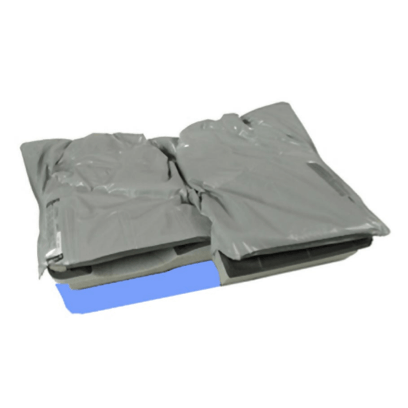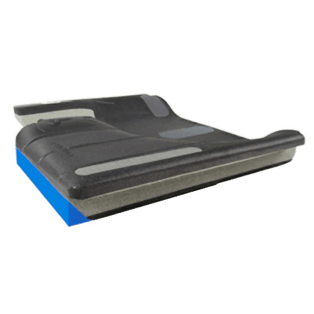Fluid cushions are versatile, with many modification options for clients with unique positioning and functional needs. In a recent blog post, we discussed how to modify the fluid volume to address these needs. However, some of the most beneficial modifications can be made to the base itself. When the base, modified or not, is then coupled with fluid, the result is a personalized cushion that meets the pressure management and positioning needs of individuals. Let's review the most commonly ordered modifications to the cushion base.
Scrotal Relief
Did you know that fluid cushions can be modified to provide scrotal relief? Both the base and the fluid pad can be modified to address this concern for an individual. The base of the cushion can be modified with a scoop out at the front and center of the pelvic loading area to accommodate organ tissue, reduce discomfort, and increase sitting tolerance (see bottom left photo). The scrotal area of the fluid pad can be heat sealed to control fluid migration in order to reduce pressure in areas that are at risk for skin breakdown, pain, or discomfort (see bottom right photo).
Thigh and Pelvic Supports
Thigh and pelvic supports can be added to fluid cushions to help achieve orientation of the pelvis and alignment of the thighs in the seated position. Lateral pelvic supports at the rear of the cushion may help improve sitting posture for an individual with narrow hips, as the supports help to orient the pelvis to the contoured well of the cushion. A medial thigh support adds a positioning piece to the front middle of the cushion to provide abduction to position the thighs. Lateral thigh supports are added to the lateral edges of the front of the cushion base to draw the thighs toward the median for adduction. The below left photo represents thigh and pelvic supports attached to a closed-cell foam base, as the pieces can be attached directly to this type of foam. The below right photo shows positioning pieces added to the pockets of an inner cover of an open-cell foam cushion, as the positioning pieces cannot be attached directly to open-cell foam. An outer cover with positioning pockets can be used with both types of foam bases. These positioning pieces can be easily added or removed according to the client's needs.
Leg Length Cut
For an individual with different femoral length requirements, a leg length cut decreases the length of the foam base and fluid pad (if applicable) on the left or the right side (see below) and provides a cushion cover to match the modification to accommodate the leg length discrepancy.

Contracture Cut
A contracture cut, in which a 45° angle is undercut at the front of the foam base (see below), has many clinical applications. This modification permits clearance for calves when there are tight hamstrings, close thigh-to-lower-leg angles, or large calves present. In addition, a contracture cut accommodates foot propulsion by providing clearance for the lower leg while also providing femoral support.

Posterior / Anterior Slope
Another modification that is important to be aware of is how to create a slope in the cushion, whether it is a posterior slope or an anterior slope. A posterior slope closes the seat-to-back angle to provide postural stability for individuals when it is clinically appropriate (for example, a posterior slope is not to be used as a "quick fix" to prevent sliding, as this does not work). A posterior slope can be achieved through one of two ways: either through an angle cut (as shown in the bottom left picture) or through the addition of a wedge glued to the base of the cushion. For the angle cut posterior slope, material is removed from the base of the cushion, such that the front of the cushion is higher than the rear of the cushion by the specified dimension. For the wedge posterior slope, the added wedge raises the height of the front of the cushion by a specified dimension, which increases the finished seat-to-floor height at the front of the cushion.
The opposite occurs for the anterior slope, which is used to open the seat-to-back angle to accommodate hip flexion limitations and assist with foot propelling and transfers. Again, either an angle cut or a wedge glued to the base may be used to create an anterior slope, such that the back of the cushion will be higher than the front of the cushion by the specified dimension. Either foam is removed at an angle from underneath the front of the cushion base, as in the angle cut anterior slope (bottom left), or a wedge is added to the base of the cushion, as in the wedge glue anterior slope (bottom right). In the case of bariatric-specific cushions, a slight anterior slope is built into the design of the cushion to accommodate for limited hip flexion due to excess tissue.
Well Size
Finally, it is possible to change the size of the well in the cushion base to accommodate anatomical differences. The well is designed to allow for immersion of the pelvis for skin protection and loading of the trochanters for stability. By changing the well size, it allows for alteration of the pelvic loading area to accommodate different pelvis sizes. For those who wish to reduce pressure at the trochanter (thereby distributing load across the whole seating surface), an available option is s trochanteric relief to modify the pelvic loading area.
Summary
Although we have explored commonly requested modifications available to the base of wheelchair cushions, there are a variety of other options available. While some modifications are so popular they have become an option on the order form, many other modifications are available to ensure optimal comfort, positioning, and function. Just ask!
Originally written by Sheilagh Sherman and published on 31 May 2022.